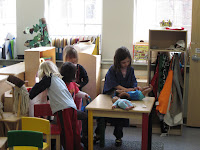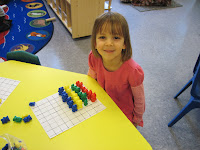This week we have been studying healthy habits in the Owls’ Classroom. We have focused on teaching the children how their bodies work, and how their choices affect their bodies.
We began our unit of study with a fun activity that taught the children why it is important to wash our hands. First, we all put lotion on our hands. Then, Morah Larissa pretended to sneeze, and slipped her hand into a tray of glitter. We pretended that the glitter was germs! The children learned that we cannot see real germs, but that they are real. Morah Larissa shook a child’s hand, and then we all shook hands. The children were able to see how germs spread through hand to hand contact.
Then we washed the glitter off our hands. We talked about how hard it was to get the pretend germs off of our hands, and reminded the children that at school, we need to wash our hands for a long time – long enough to sing the “ABCs” or “Twinkle, Twinkle, Little Star.”

We deepened our study of germs and our immune systems with a visit from Kylan’s mother, Kristi Guinn. She talked to the children about her work as a scientist, Kristi read the children I Know How We Fight Germs, by Kate Rowan. They had many thoughtful questions for her. Thank you so much, Kristi!

 Pretend play is crucial to the social and emotional development of four- and five-year-olds as they learn to negotiate with other children, to take turns leading and following other children and to share materials.
Pretend play is crucial to the social and emotional development of four- and five-year-olds as they learn to negotiate with other children, to take turns leading and following other children and to share materials.
We have also enjoyed using some traditional medical supplies in unusual ways this week. We used q-tips to paint with liquid watercolors at the art table and used tweezers to move cotton balls into egg cartons. Both of these sensory experiences (the small thin q-tips and the challenging tweezers) build children’s hand strength.
We also introduced some concepts about nutrition this week. The children enjoyed looking at grocery ads at the Writing Center and practiced copying some of the text from these ads. Because grocery ads contain pictures of the foods with labels, they are a wonderful way for children to engage in writing while making meaning from text at the same time. The children also enjoyed using word cards to write about their favorite foods – and they even tried writing lower case letters.
At Morning Meeting on Wednesday, we pretended to take a field trip to the grocery store. The children pretended to go shopping and picked out a photograph of a food. We sorted our “purchases” into 3 shopping bags, one labeled “Always,” one labeled “Sometimes,” and one labeled “Just a Little Bit.” The children learned that “Always” foods are foods that we can always choose to eat, because they fill us up and give our bodies energy, help our muscles, or make our bones stronger. We put photographs of green beans, yogurt, milk, and whole-grain crackers into the “Always” bag. We learned that some foods help our bodies grow and get stronger, but they might have things like fat or sugar in them that are not good for our bodies if we eat too much. We put those foods (like pizza and sugar-filled cereals) into the “Sometimes” bag. Finally, we found some foods that taste good, but do not help our bodies grow or get stronger! We put those foods (such as chocolate and candy) into the “Just a Little Bit” bag. We talked about how we eat “Just a Little Bit” of these foods. Then the children created their own collages, using cut-out pictures of food. They sorted their choices into boxes labeled “Always,” “Sometimes,” and “Just a Little Bit.”
The children also were each invited to join Morah Larissa at the computer, where we looked at a nutrition website aimed at preschoolers from the federal government. On the preschool section of http://www.mypyramid.gov/, the children were able to type in their names, click on their age and then print out their own personalized food pyramid! We talked about how the food pyramid helps us decide what kinds and how much food to eat. This was a meaningful way for the children to interact with technology to gain information. In addition, these are some of the resources that we have used at school to coach children through meal times.
While we have had a special focus on healthy habits this week, we discussed concepts of personal hygiene (such as brushing teeth and washing hands) as well as healthy eating habits throughout each and every day at school. This week has allowed us to explicitly focus on some of the language and ideas that we discuss at snack time, lunch time and every time we enter the room and wash our hands!
Shabbat Shalom,
Morah Larissa and Morah Kate

















